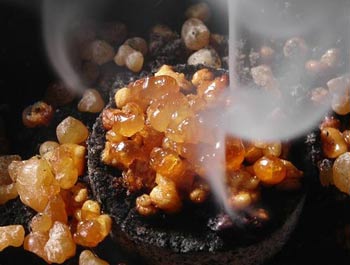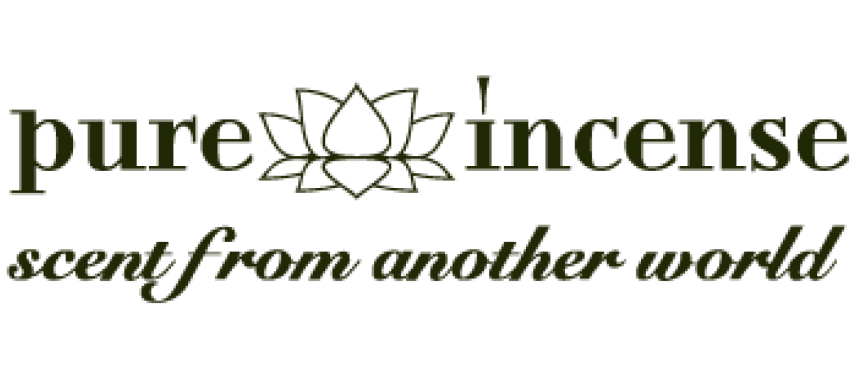Information on Frankincense Incense
“The body soon dissolv’d, and all around
Perfum’d with heav’nly fragrances the ground,
A sacrifice for Gods up-rose from thence,
A sweet, delightful tree of frankincense.” – Ovid
Frankincense is Obtained from the leafy forest tree Boswellia Thurifera, Synonym—Olibanum.
The trees grow without soil, out of polished marble rocks, to which they are attached by a thick oval mass of substances resembling a mixture of lime and mortar. The young trees furnish the most valuable gum, the older yielding merely a clear, glutinous fluid, resembling coral varnish.

To obtain the Frankincense, a deep, longitudinal incision is made in the trunk of the tree and below it a narrow strip of bark 5 inches in length is peeled off. When the milk-like juice which exudes has hardened by exposure to the air, the incision is deepened. In about three months the resin has attained the required degree of consistency, hardening into yellowish ‘tears.’ The large, clear globules are scraped off into baskets and the inferior quality that has run down the tree is collected separately.
It is a stimulant, but seldom used now internally, though formerly was in great repute. Pliny mentions it as an antidote to hemlock. Avicenna (tenth century) recommends it for tumours, ulcers, vomiting, dysentery and fevers. In China it is used for leprosy. Its principal use now is in the manufacture of incense and pastilles. It is also used in plasters and might be substituted for Balsam of Peru or Balsam or Tolu. The inhalation of steam laden with the volatile portion of the drug is said to relieve bronchitis and laryngitis.
Use and History of Frankincense Incense
Frankincense is the best known of the aromatic gum resins used throughout the world as incense in religious ceremonies. The earliest recorded use of frankincense is found in an inscription on the tomb of a 15th century BC Egyptian queen named Hathsepsut. Ancient Egyptians burned frankincense as incense and ground the charred resin into a powder called kohl. Kohl was used to make the distinctive black eyeliner seen on so many figures in Egyptian art.
The earliest archaeological evidence for the burning of incense comes from the Old Kingdom in Ancient Egypt, where spoon-shaped incense burners with long handles have been found. However, no chemical evidence exists of the exact resin used. Dr Richard Evershed and colleagues from the University of Bristol managed to chemically characterise frankincense from the archaeological record at the site of Quasr Ibrim, Egyptian Nubia.
The ceremonial incense of the Jews was compounded of four ‘sweet scents,’ of which pure Frankincense was one, pounded together in equal proportion. It is frequently mentioned in the Pentateuch. Pure Frankincense formed part of the meet offering and was also presented with the shew-bread every Sabbath day. With other spices, it was stored in a great chamber of the House of God at Jerusalem.
Frankincense or Boswellia Tree is a 5 meters high tree with an upstanding trunk or trunks branched from the ground. Twigs are dense and intertwined. Leaves are also twisted with thin crusts. The tree grows in the coastal line and mountains slopes in Yemen. Frankincense is now used as painting and coating for its instant drying. It is also used in perfumes industry. When boiled in water, it can be used in cough and throat inflammation.
According to Herodotus, Frankincense to the amount of 1,000 talents weight was offered every year, during the feast of Bel, on the great altar of his temple in Babylon. The religious use of incense was as common in ancient Persia as in Babylon and Assyria. Herodotus states that the Arabs brought every year to Darius as tribute 1,000 talents of Frankincense, and the modern Parsis of Western India still preserve the ritual of incense. Among the Romans, the use of Frankincense (alluded to as mascula thura by Virgil in the Eclogues) was not confined to religious ceremonials. It was also used on state occasions, and in domestic life. Frankincense is also melted to make a depilatory, and it is made into a paste with other ingredients to perfume the hands. A similar practice is described by Herodotus as having been practiced by the women of Scythia and is alluded to in Judith x. 3 and 4. In cold weather, the Egyptians warm their rooms with a brazier whereon incense is burnt, Frankincense, Benzoin and Aloe wood being chiefly used for the purpose.
The word ‘incense,’ meaning originally the aroma given off with the smoke of any odoriferous substance when burnt, has been gradually restricted almost exclusively to Frankincense, which has always been obtainable in Europe in greater quantity than any other of the aromatics imported from the East.
Trade of frankincense dates back to the ancient Mediterranean civilisations of Egypt, Greece and Rome. It is also the famous incense from the bible thought to awaken a feeling of union with the divine. With a characteristic purifying and relaxing quality its Yang character is thought to strengthen willpower, self-confidence and determination.
According to Christian belief, the three wise men who traveled to Bethlehem to worship the Christ Child brought gold, frankincense and myrrh as gifts. Thanks to the domestication of the camel, a complex trade network evolved to transport the priceless resins from the remote valleys, where the trees grew, to the markets where kings and emperors vied for the finest grades.
To see our range of Frankincense Incense please click below:
Shop for Frankincense Incense
